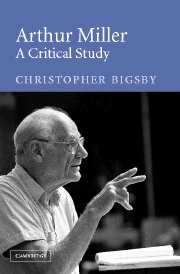Book contents
- Frontmatter
- Contents
- Acknowledgements
- Note on the text
- Introduction
- 1 The Michigan plays
- 2 The Golden Years, The Half-Bridge, Boro Hall Nocturne
- 3 The radio plays
- 4 The Man Who Had All the Luck
- 5 Focus
- 6 All My Sons
- 7 Death of a Salesman
- 8 Arthur Miller: time-traveller
- 9 An Enemy of the People
- 10 The Crucible
- 11 A Memory of Two Mondays
- 12 A View from the Bridge
- 13 Tragedy
- 14 The Misfits
- 15 After the Fall
- 16 Incident at Vichy
- 17 The Price
- 18 The Creation of the World and Other Business
- 19 The Archbishop's Ceiling
- 20 Playing for Time
- 21 The shearing point
- 22 The American Clock
- 23 The one-act plays: Two-Way Mirror, and Danger: Memory!
- 24 The Ride Down Mount Morgan
- 25 The Last Yankee
- 26 Broken Glass
- 27 Mr Peters' Connections
- 28 Resurrection Blues
- 29 Finishing the Picture
- 30 Fiction
- 31 Arthur Miller as a Jewish writer
- Notes
- Index
9 - An Enemy of the People
Published online by Cambridge University Press: 16 November 2009
- Frontmatter
- Contents
- Acknowledgements
- Note on the text
- Introduction
- 1 The Michigan plays
- 2 The Golden Years, The Half-Bridge, Boro Hall Nocturne
- 3 The radio plays
- 4 The Man Who Had All the Luck
- 5 Focus
- 6 All My Sons
- 7 Death of a Salesman
- 8 Arthur Miller: time-traveller
- 9 An Enemy of the People
- 10 The Crucible
- 11 A Memory of Two Mondays
- 12 A View from the Bridge
- 13 Tragedy
- 14 The Misfits
- 15 After the Fall
- 16 Incident at Vichy
- 17 The Price
- 18 The Creation of the World and Other Business
- 19 The Archbishop's Ceiling
- 20 Playing for Time
- 21 The shearing point
- 22 The American Clock
- 23 The one-act plays: Two-Way Mirror, and Danger: Memory!
- 24 The Ride Down Mount Morgan
- 25 The Last Yankee
- 26 Broken Glass
- 27 Mr Peters' Connections
- 28 Resurrection Blues
- 29 Finishing the Picture
- 30 Fiction
- 31 Arthur Miller as a Jewish writer
- Notes
- Index
Summary
An Enemy of the People was unusual among Ibsen's plays. It was written quickly, being staged within a year of Ghosts, whose negative reviews in part explained its mood. It is an angry play, and one in which the idealism of its central character is presented without quite so many of the unfolding ambiguities and ironies as attach themselves to The Wild Duck, for example, and which Miller echoed in All My Sons. Like Ghosts it is about corruption, but the corruption here is to the body politic, to a venal business world, a tainted media and a vacillating and self-serving liberalism for which compromise and moderation are the fundamental tenets. In other words it is a play with multiple targets.
To be sure, the central character, Dr Stockmann, has flaws of his own. He suffers from pride, arrogance and a belief in the moral and social primacy of the intellectual. These, however, are elements that Ibsen presents but does not explore, and that Miller would not choose to elaborate.
An Enemy of the People concerns a small Norwegian community about to break out of its torpor and provincialism thanks to a newly developed spa, the inspiration of Dr Stockmann, whose work has revealed the special properties of its waters. His brother, the Mayor, part of the syndicate operating the baths, is one of the city elders to benefit.
- Type
- Chapter
- Information
- Arthur MillerA Critical Study, pp. 138 - 146Publisher: Cambridge University PressPrint publication year: 2004



